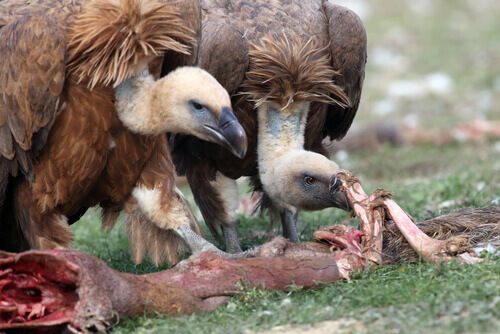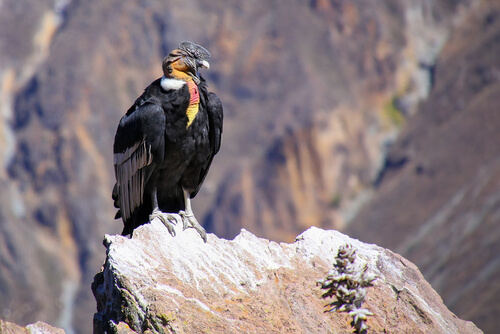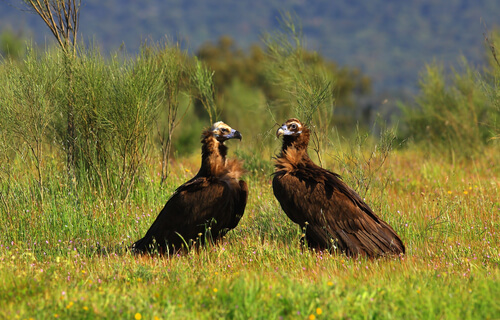10 Scavenger Birds

Scavenging animals are animals that consume carcasses that they have neither hunted nor killed. And, believe it or not, they have a very useful role to play in the ecosystem: to eliminate decomposing organic remains. Among them, we can find scavenger birds. Would you like to know what they are?
Examples of scavenger birds
Not only birds engage in this feeding activity; there are also insects and even mammals such as raccoons that consume the remains of animals that have been hunted by others. In the case of scavenger birds, they can even fight with large predators for food. Among them, we can highlight:
1. Griffon vulture (Gyps fulvus)
This is one of the few vultures that inhabit Europe, although it’s also found in North Africa, the Arabian Peninsula, and South Asia (as far as India). It prefers mountainous areas with rocks and deep valleys.
The griffon vulture – in the featured photo of this article – has a wingspan of more than 2.5 meters (8.2 feet) and weighs about 10 kilos (22 lbs). Its feathers are cinnamon or ochre in color, its head and neck are white, and its grayish, hooked beak – typical of birds of prey – allows it to tear fabrics and skins. Thanks to its powerful eyesight, it can spot carcasses at a distance of several meters.
2. Bearded vulture (Gypaetus barbatus)
The bearded vulture is another of the best-known carrion birds, which can be seen in the Cantabrian Mountains, the Alps, the Pyrenees, North and South Africa, Eastern Europe, and even the Himalayas.

As for their plumage, it varies according to age; when they’re adults they can have brown, black, white and gray colors, and, in addition, they have the typical hooked beak and small but very developed eyes.
3. Andean Condor (Vultur gryphus)
This is one of the few scavenger birds of South America, specifically of the Andes mountain range, which is characterized by its black and gray plumage, with a white neck and bare head. Males are larger than females and have a crest and folds on the face that grow with age.

The Andean condor feeds on dead animals, but once they spot them, they spend hours or even days flying over them. With their strong beaks, they tear tissue and hides, and are able to feed for a whole day: they can eat five kilos of meat in one sitting! This is after five weeks of fasting.
4. Egyptian Vulture (Neophron percnopterus)
This is another of our scavenger birds. It not only lives in Egypt, but is also present in the Iberian Peninsula, North and Central Africa, and Southeast Asia.

It’s small compared to other vultures; juveniles are brownish in color and adults have yellow legs and head, a white body, and wings with dark tips and a completely light tail.
When carrion is present, the Egyptian vulture is one of the last to approach to eat; it waits for the larger animals to take care of the meat and then gobbles skins or fat. It complements its diet with insects, eggs or small prey.
5. Golden eagle (Aquila chrysaetos)
The golden eagle is one of the largest birds, measuring between 90 and 100 centimeters (35 to 40 inches) in height and 2.27 meters (7.5 feet) in wingspan. It has a beautiful chestnut color on its back with lighter colors on its belly.
Its feathers are quite elongated and each has a small white spot. The diet of this fearsome hunter is based on lagomorphs such as hares, but it’s capable of eating carrion when the resources are scarce.
6. Magpie (Pica pica)
The magpie is a beautiful bird characterized by its unmistakable black and white coloration. It’s distributed in some temperate regions of Asia, Africa, Arabia, North America and Europe. The beak of this species isn’t adapted to a specific diet, so it eats everything from insects and cereals to carrion, eggs, and chicks of other birds.
7. Black kite (Milvus migrans)
The kite is a bird of prey that measures between 50 and 60 centimeters (20 to 23 inches) in length, although it has a wingspan of almost one and a half meters (5 feet). It has a migratory behavior, so, depending on the time of year, it can be found in Africa, Europe, Asia, and Oceania.
Its diet is based on hunting birds, fish, mammals, amphibians, and reptiles, but it’s capable of feeding on carrion when necessary.
8. Jackdaw (Coloeus monedula)
This bird is very similar in appearance to crows, as it’s one of their close relatives. It measures about 33 centimeters (13 inches) in length and has a wingspan of 67 centimeters (2.2 feet). Its plumage exhibits a combination of dark brown and black colors, with a lighter grayish head.
The jackdaw’s diet is opportunistic and adapts to whatever is available, which includes carrion.
9. Carrion crow (Corvus corone)
This species can be confused with its relatives the jackdaw and crow because of its small size and dark plumage. It can be found in much of Europe, parts of Asia and Egypt. It has an omnivorous diet that is able to adapt to the availability of its food, consuming insects, seeds, grains, small mammals, and carrion of all kinds.
10. Black vulture (Aegypius monachus)
The last of the carrion birds is native to Asia, although it can also be found in southern Europe, always in ravines and cliffs. The feathers are dark, though not necessarily black, and its head is lighter in color, giving it the appearance of being bald. There are no differences between the sexes.

We hope you enjoyed our look at scavenger birds. Why not take a look at the article we’ve specially selected for you below on the same topic!
All cited sources were thoroughly reviewed by our team to ensure their quality, reliability, currency, and validity. The bibliography of this article was considered reliable and of academic or scientific accuracy.
- Procuraduría Federal de Protección al Ambiente. (2020). Águila Real, especie emblemática de México. Recuperado el 9 de enero de 2022, disponible en: https://www.gob.mx/profepa/articulos/91717
- Unidad de coordinación del MdE de la CMS sobre rapaces. (2017). Resumen del Plan de Acción de múltiples especies para la conservación de los buitres de África y Eurasia. Recuperado el 9 de enero de 2022, disponible en: https://www.cms.int/raptors/sites/default/files/publication/vulture-msap_summary_s.pdf